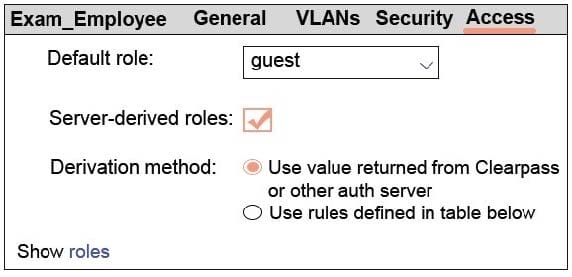Exam Details
Exam Code
:HPE6-A42Exam Name
:Implementing Aruba WLAN (IAW) 8Certification
:HP CertificationsVendor
:HPTotal Questions
:129 Q&AsLast Updated
:Mar 29, 2025
HP HP Certifications HPE6-A42 Questions & Answers
-
Question 91:
A company has an Aruba solution and wants to provide guests with wireless access. The company wants to assign guests IP addresses in subnets that exist only within the Aruba solution.
Which feature should network administrators set up so guests can send traffic on the Internet without changes to the company routing solution?
A. Enable NAT on the VLAN assigned to the guest WLAN.
B. Set up a dynamic default gateway on the Mobility Controllers (MCs).
C. Create destination NAT rules for the guest role.
D. Enable policy-based routing for the guest traffic.
-
Question 92:
Refer to the exhibit.

A network administrator sets up the Exam_Employees WLAN on an Aruba solution with a default role of guest, as shown in the exhibit. To which users does the guest role apply?
A. users who successfully authenticate and are assigned to the default role by the RADIUS server
B. users who successfully authenticate and are not assigned a different role by the RADIUS server
C. users who have connected to the SSID, but have not yet attempted authentication
D. users who fail authentication
-
Question 93:
Which settings can a Mobility Master (MM) deploy to Mobility Controllers (MCs) but master controllers CANNOT deploy to local controllers?
A. radio profiles
B. AAA profiles
C. VLAN settings
D. WLAN settings
-
Question 94:
A company has an Aruba Mobility Master (MM)-based solution. Where can network administrators look to monitor the health status of all controllers, APs, and clients?
A. the top banner
B. the MM Maintenance pages
C. the Performance dashboard
D. the Potential Issues dashboard
-
Question 95:
A network administrator creates an employee WLAN on an Aruba solution that uses WLAN WPA2Enterprise security and an external RADIUS server. When the administrator tests the WLAN, the test client receives limited connectivity and cannot access any resources, but the RADIUS server shows that the user authenticated successfully.
What should the administrator check as a possible source of this issue?
A. the connectivity between the AP that the client is associated to and the MC
B. the firewall role and policy that apply to this user
C. the certificate on the RADIUS server
D. the connectivity between the Master Controller (MC) for the client and the RADIUS server
-
Question 96:
How does a high-gain omni-directional antenna compare to a typical omni-directional antenna?
A. it provides more multi-user spatial streams.
B. it provides more coverage in the horizontal direction than in the vertical direction.
C. it provides more single-user spatial streams.
D. it provides more coverage in both the horizontal and vertical directions.
-
Question 97:
A company has a single Aruba Mobility Master (MM)-based solution with two Mobility Controllers (MCs). Network administrators want APs in building 1 to support a WLAN but do not want APs in building 2 to support the WLAN.
How can administrator ensure that they can enforce this rule as they set up the WLAN in the Mobility Master (MM) Interface?
A. Place APs in different buildings in different AP Groups.
B. Assign APs in different buildings to different MM nodes.
C. Configure APs in different buildings to use different frequency bands.
D. Assign different radio profiles to APs in different buildings.
-
Question 98:
What is one difference between captive portal authentication and 802.1X authentication?
A. 802.1X authentication always authenticates the wireless client, while captive portal authentication always authenticates the wireless user.
B. 802.1X authentication occurs at Layer 2, while captive portal authentication occurs at Layer 3.
C. 802.1X authentication must use an LDAP server, while captive portal authentication can use a RADIUS server or an LDAP server.
D. 802.1X authentication is typically implemented without encryption, while captive authentication is often combined with WPA or WPA2.
-
Question 99:
A company deploys a wireless network in a typical office environment with many surfaces where the signal can bounce. Which 802.11 technology uses the characteristics of this environment to increase wireless speeds?
A. Channel bonding
B. Multiple Input Multiple Output (MIMO)
C. Transmit Power Control (TPC)
D. QAM modulation
-
Question 100:
Refer to the exhibit.

What describes the behavior for this WLAN?
A. APs in the default group broadcast the SSID. Clients can connect to the WLAN on APs in the default group only.
B. No APs broadcast the SSID. Clients cannot connect to the WLAN until administrators activate it.
C. No APs broadcast the SSID. Clients can connect to the WLAN on APs in the default gorup only.
D. APs in the default group broadcast the SSID. Clients can connect to the WLAN on APs in any group.
Related Exams:
HP0-D15
Administering HP CloudSystem Matrix SolutionsHP0-D20
Architecting the HP Matrix Operating EnvironmentHP2-E56
Selling HP SMB SolutionsHP2-H88
Selling HP Business Personal Systems Hardware 2019HP2-I14
Selling HP Supplies 2020HP2-I15
Selling HP Business Personal Systems Hardware 2020HP2-I17
Selling HP Printing Hardware 2020HP2-I44
Selling HP Workstations 2022HP2-I73
Selling HP Retail and Hospitality Solutions 2024HP2-N51
HP Application Lifecycle Management 12.x Software
Tips on How to Prepare for the Exams
Nowadays, the certification exams become more and more important and required by more and more enterprises when applying for a job. But how to prepare for the exam effectively? How to prepare for the exam in a short time with less efforts? How to get a ideal result and how to find the most reliable resources? Here on Vcedump.com, you will find all the answers. Vcedump.com provide not only HP exam questions, answers and explanations but also complete assistance on your exam preparation and certification application. If you are confused on your HPE6-A42 exam preparations and HP certification application, do not hesitate to visit our Vcedump.com to find your solutions here.